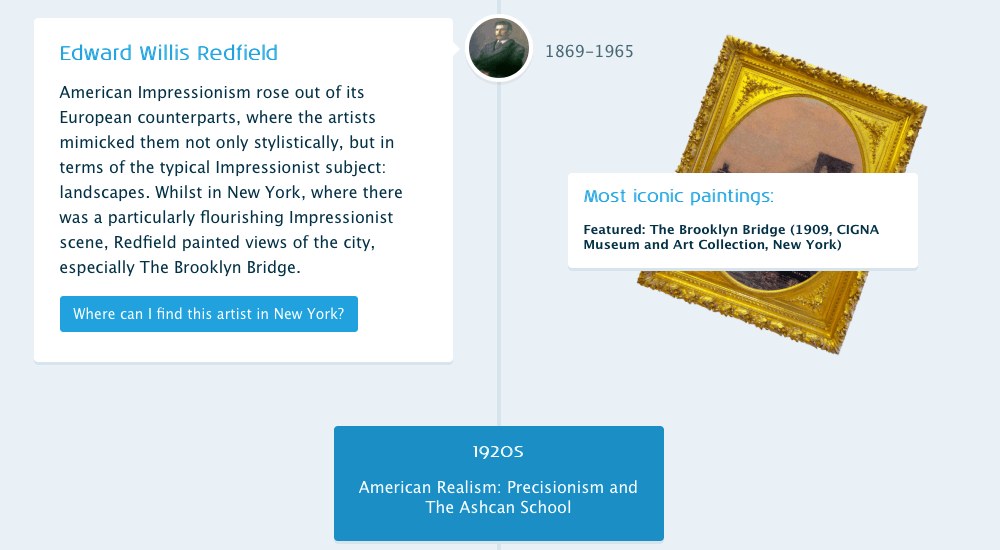From the American Impressionism of the late 19th and early 20th Century to Neo-Conceptualism of today, together with KLM Royal Dutch Airlines we look at which artists shaped the art history of New York and where you can see their work.
1890s-1920s : American Impressionism
Edward Willis Redfield (1869-1965)
American impressionism rose out of its European counterparts, where the artists mimicked them not only stylistically, but in terms of the typical impressionist subject: landscapes. Whilst in New York, where there was a particularly flourishing impressionist scene, Redfield painted views of the city, especially The Brooklyn Bridge.
Edward Willis Redfield’s work can be seen at the Metropolitan Museum of Museum of Art
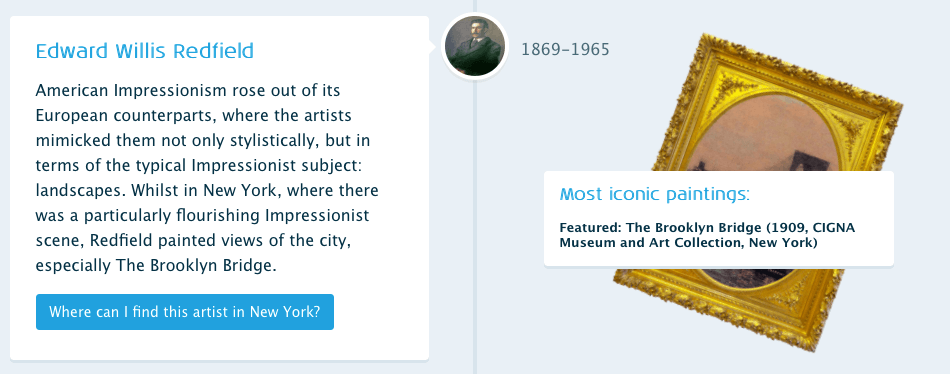
Edward Willis Redfield’s work can be seen at the Metropolitan Museum of Museum of Art
1920s : American Realism: Precisionism and The Ashcan School
George Bellows (1882-1925)
As Impressionism started to fall out of fashion in both America and Europe in flavour of early 20th century Modernism, a group of New York Artists termed the Ashcan School came to prominence. They focused on painting the everyday, lower-class immigrant life of New York. Bellows was a part of this group who was especially concerned with capturing the grittiness and violence of New York’s underbelly, as seen in his infamous series of wrestling paintings.
George Bellows’ work can be seen at the Museum of Modern Art and the Whitney Museum
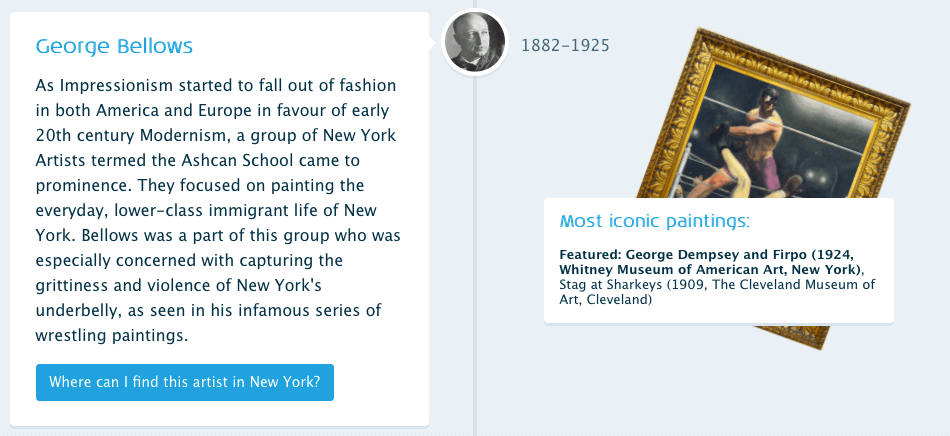
George Bellows’ work can be seen at the Museum of Modern Art and the Whitney Museum
Edward Hopper (1882-1967)
Another urban realist who was part of the Ashcan School, Hopper, unlike his contemporary Bellows, was known for painting quiet interiors. His most iconic pieces are scenes of a quiet café or diner, being viewed from outside through a glass window, creating panoramic, almost cinematic scenes.
Edward Hopper’s work can be seen at the Whitney Museum
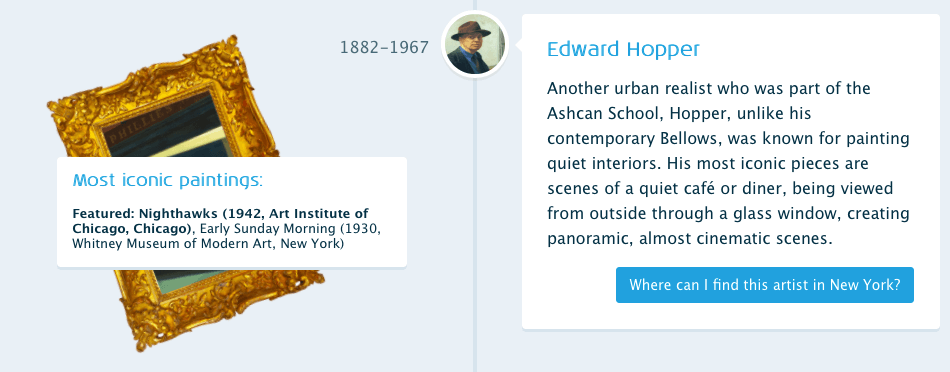
Edward Hopper’s work can be seen at the Whitney Museum
Charles Demuth (1883-1935)
Known as the first art movement to originate from America, Precisionism celebrated urbanisation, taking inspiration from geometric features of skyscrapers, streets and other metropolitan features. Stylistically, there was an emphasis on clarity of the image on the canvas. I Saw the Figure 5 in Gold is one of Demuth’s most iconic paintings, and very typical of Precisionism: the sharp, clear images create an almost metallic texture, mimicking the sleek steel and glass infrastructure of the (then newly built) American cityscape.
Charles Demuth’s work can be seen at the Metropolitan Museum of Modern Art and the Whitney Museum
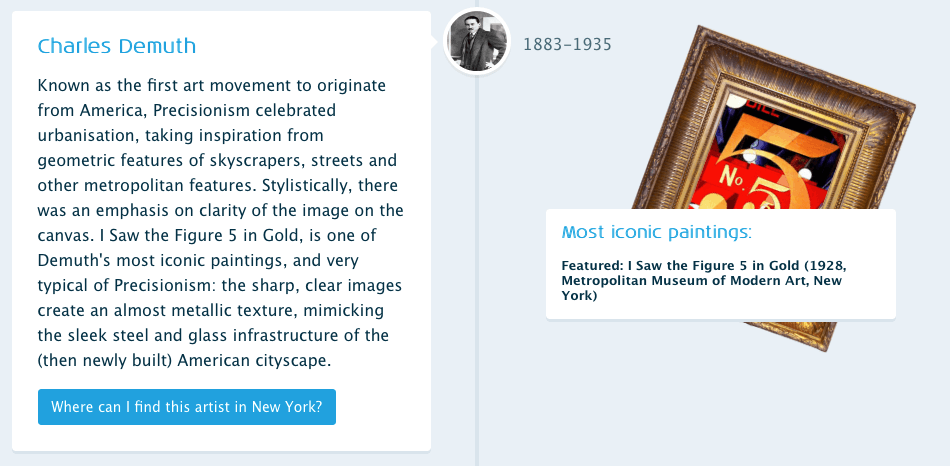
Charles Demuth’s work can be seen at the Metropolitan Museum of Modern Art and the Whitney Museum
1940s-1960s : Abstract Expressionism: Colour Field and Action Paintings
Mark Rothko (1903-1970)
Initially interested in mythology and the social psychology of Jung, Rothko engaged in Surrealism to discuss human nature. However, his most iconic work was during his ‘multiform’ period: where he abandoned any particular form or image, instead painting blocks of flat colour. These were initially supposed to convey man’s spiritual emptiness, but soon realised they represent the artistic potential of the canvas, and symbolically, the human emotion that ultimately motivates virtually all art.
Mark Rothko’s work can be seen at the Whitney Museum, the Museum of Modern Art and the Met Museum
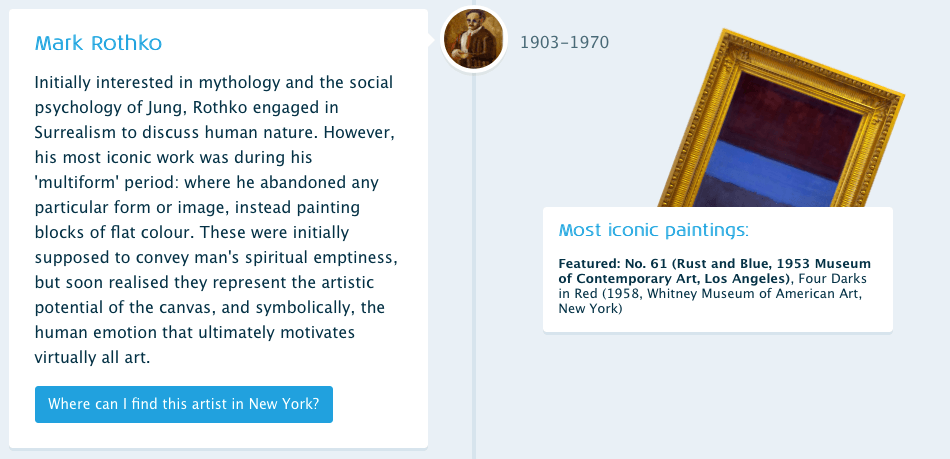
Mark Rothko’s work can be seen at the Whitney Museum, the Museum of Modern Art and the Met Museum
Willem de Kooning (1904-1997)
In the mid-20th century, Dutch expat De Kooning was part of the American Abstract Expressionist boom, along with Jackson Pollock. Inspired by Picasso, his most iconic series of paintings (all entitled Woman) deconstructed the female body to its basic geometric form, almost in a child-like manner. This was done largely to subvert the way in which the women’s bodies were often sexualised and fetishized in ‘traditional’ art.
Willem de Kooning’s work can be seen at the Museum of Modern Art and the Guggenheim Museum
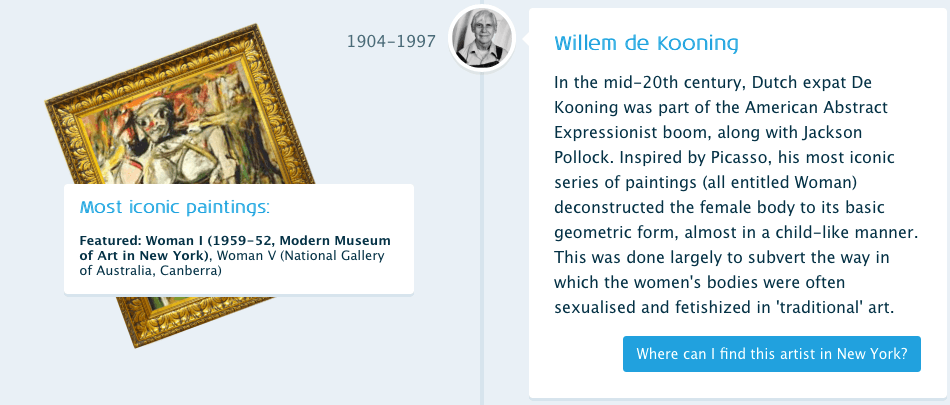
Willem de Kooning’s work can be seen at the Museum of Modern Art and the Guggenheim Museum
Jasper Johns (1930-present)
Active in the 1950s, just before the advent of Pop Art, Johns was one of the first well-known artists to break away from the domination of the abstract art and into figurative art, where the painting on the canvas visually imitates the object that it’s drawn from. His most famous work, that of the American flag, marks a new trend of artistically recreating famous symbols and images from popular culture, marking the advent of Pop Art.
Jasper Johns’ work can be seen at the Museum of Modern Art
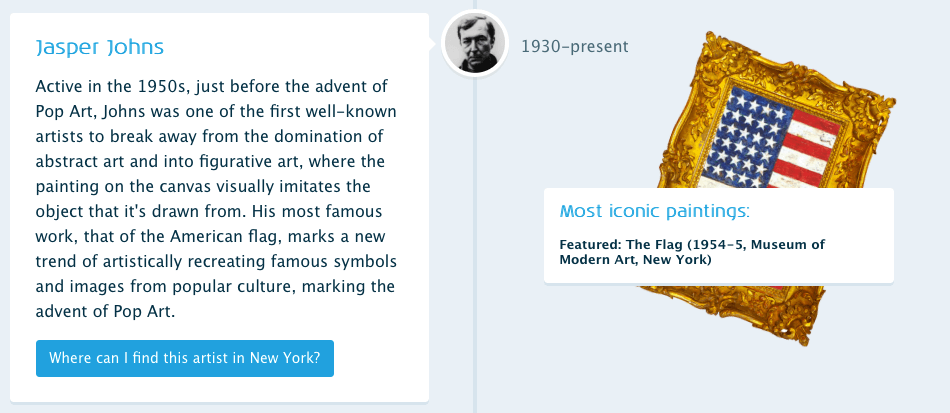
Jasper Johns’ work can be seen at the Museum of Modern Art
Jackson Pollock (1948-present)
The American post-WWII response to the slightly earlier German Expressionism (which emphasised portraying emotion and subjectivity over realism). These artists took the psychological elements of Surrealism and German Expressionsm to new heights to create art that was ‘simultaneous’. For Pollock, this meant to spontaneously splash a canvas with paint, to emphasise the physical act and process of painting: hence the term, ‘action’ painting.
Jackson Pollock’s work can be seen at the Museum of Modern Art and the Guggenheim Museum
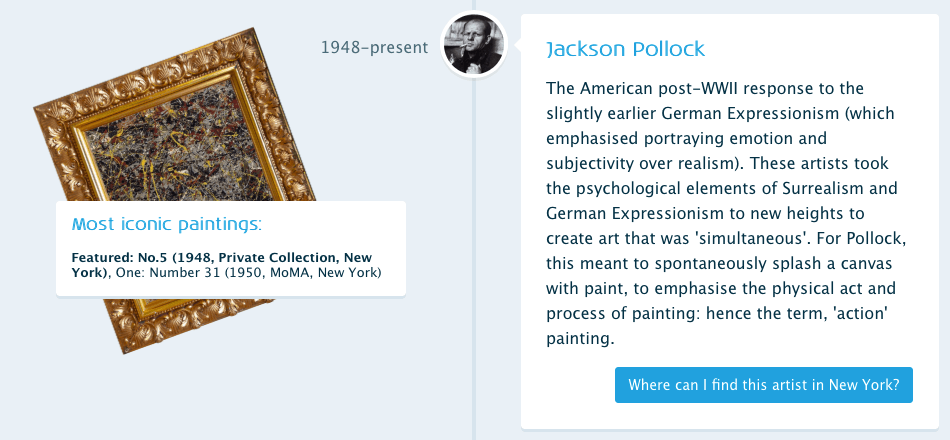
Jackson Pollock’s work can be seen at the Museum of Modern Art and the Guggenheim Museum
1950s-1960s : Pop Art
Roy Lichtenstein (1923-1997)
Influenced by advertising, but primarily comic books, Lichtenstein is yet another Pop Art icon. His signature was to imitate the colour and format of comic book panels, even going so far as to use Bengay dots – different shades of painted dots that appear to meld together as an optical illusion to create new shades of colour – to create the effect that the picture was printed rather than being painted, but has the illusion of a comic book panel has been printed on the canvas.
Roy Lichtenstein’s work can be seen at the Museum of Modern Art and the Metro Museum
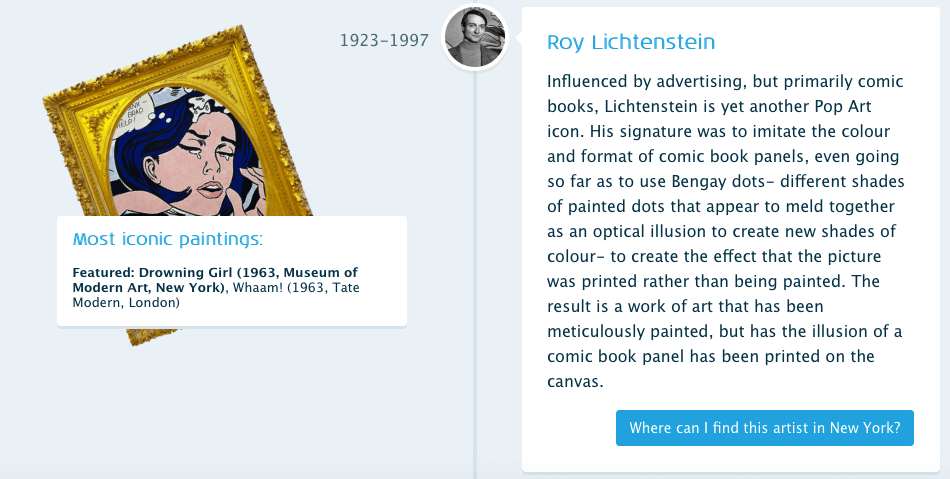
Roy Lichtenstein’s work can be seen at the Museum of Modern Art and the Metro Museum
Andy Warhol (1928-1987)
Pop Art developed in the 60s after mass media and advertising became ubiquitous in American culture. Decidely moving away from Rothko and the non-representational art forms, Pop Art sought to blur mimic the lines between ‘high’ art and ‘low’ mass produced pop culture. Andy Warhol was part of the avant-garde scene in Manhattan, where he developed in his most iconic works (including Campbell’s Soup Cans) in his infamous studio on 47th Street, The Factory which has since been sadly torn down.
Andy Warhol’s work can be seen at the Museum of Modern Art and the Whitney Museum
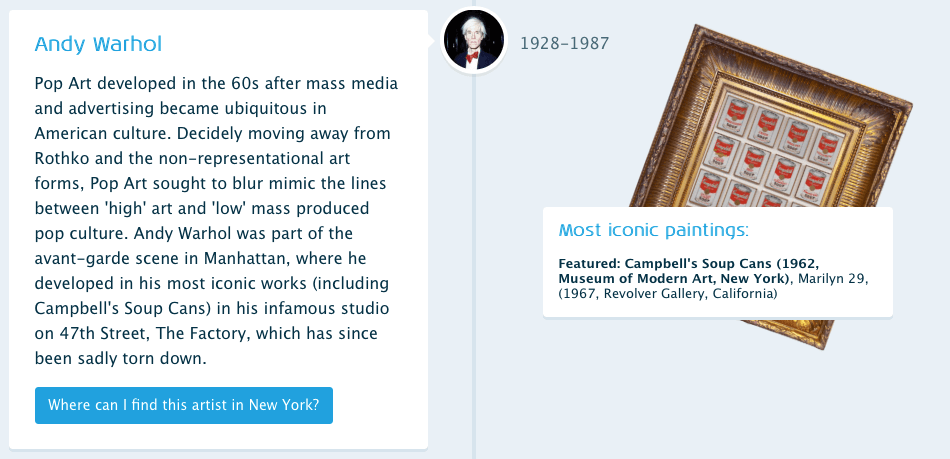
Andy Warhol’s work can be seen at the Museum of Modern Art and the Whitney Museum
1980s-Present : Conceptualism/Neo-Conceptualism
Barbara Kruger (1945-present)
Like the Pop Artists before her, Barbara Kruger made use of commercial images to comment on social attitudes. Often using a combination of both text and image, she would write using short, punctuated statements that echo advertising slogans, such as ‘I shop therefore I am’, therefore appropriating the very format of commercialism in order to criticize it.
Barbara Kruger’s work can be seen at the Mary Boone Gallery
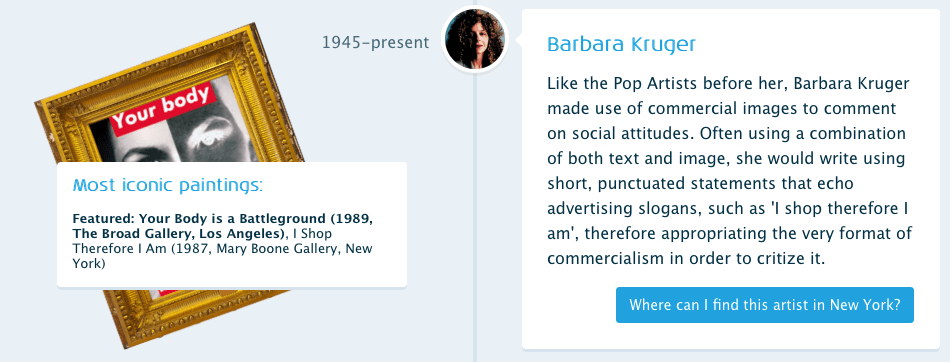
Barbara Kruger’s work can be seen at the Mary Boone Gallery
Jeff Koons (1955-present)
Koons, although coming from a different generation, was engaged with a similar concern as the Pop Artisits: that of ‘high’ and ‘low’ art. He specifically creates sculptures that are larger-than-life. Often painted in garish, bright colours, which according to him, have no symbolic or hidden meanings. The kitschy nature of his works makes him a highly polarising figure, being lauded and criticised eqully for either being revolutionary or merely being too crass.
Jeff Koons’ work can be seen at the Gagosian Gallery and the Whitney Museum
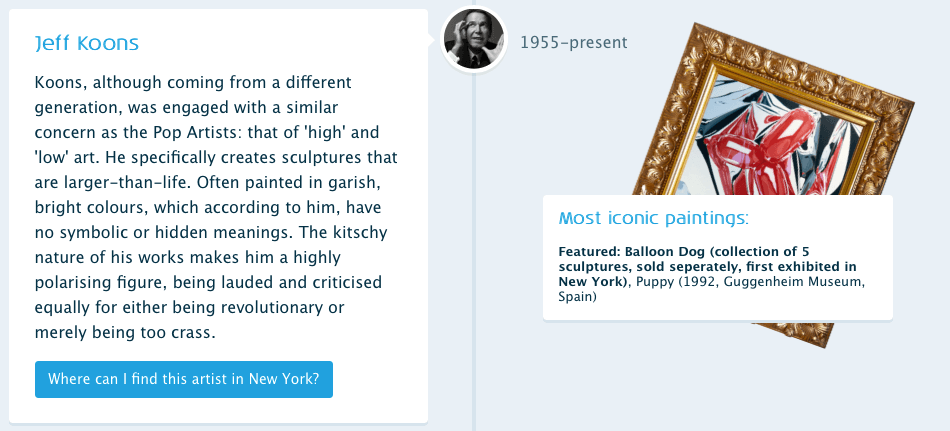
Jeff Koons’ work can be seen at the Gagosian Gallery and the Whitney Museum

